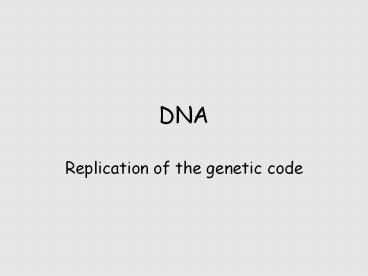DNA PowerPoint PPT Presentation
1 / 21
Title: DNA
1
DNA
- Replication of the genetic code
2
DNA recipe book
- Instructions for ALL proteins are encoded by DNA
- DNA resides in the nucleus
- To pass on instructions for life, need to
replicate DNA prior to reproduction
3
How do we know DNA is the genetic code of life?
- Some late 19th century observations of dividing
cells gave us some clues
4
Observations
- Late 1800s Walther Flemming sees threads
moving changing during cell division - Threads appear paired prior to cell division
- Paired threads separate just prior to division
- Named the thread separating process Mitosis
5
Observations on thread
- Thread differs between species
- Roundworms 4 Peas 14 Humans 46
- Thread identical between individuals within a
species - All roundworms 4
- Same between cells within an individual
- Threads were named chromosomes which consist of
both DNA protein
6
Is it DNA or proteins that are important?
- Chromosomes consist of both, so how did
scientists identify which one holds instructions
for reproduction of cells?
7
DNAs discovery
- 1952 Hershey Chase find that bacteriophage
virus infects and reprograms bacteria to make
more virus - Consists only of external protein coat and
internal DNA - Inserts its DNA into bacteria, protein coat
remains outside - A perfect model!
8
Label DNA protein separately
- Radioactive Sulfur incorporates into proteins
only. Why? - Heavy bacterial cells settle, while lighter phage
particles remain in solution. (wheres the
radioactivity?)
9
Label DNA protein separately
- Radioactive Phosphorous incorporated into DNA.
Why? - Heavy bacterial cells settle, while lighter phage
particles remain in solution. (wheres the
radioactivity?)
10
DNA encodes instructions for replication!
11
DNAs structure
- Whats it look like? Does its structure suggest
how replication is accomplished?
12
Monomers of DNA Nucleotides
- Repeated phosphate, sugar, base motif of ALL
nucleotides - Phosphate-sugar backbone
- Base only difference between nucleotides
13
Nitrogenous Bases
- Purines G, A 2 nitrogenous rings
- Pyrimidines C, T 1 nitrogenous ring
14
Who discovered the structure?
- J. Watson F. Crick deduced double-stranded,
helical structure from Rosalind Franklins X-ray
crystallographic image of a DNA molecule.
15
Chemical structure
16
Conclusions
- Molecule is of uniform width
- Amounts of A T are identical same for C G
- H-bonds hold bases of neighboring strands
together - suggests precise complimentarity between
nucleotides - Adenine always pairs with Thymine Cytosine
always pairs with Guanine
17
Extensions
- Sequence possibilities are limitless (variation
in sequence could account for the diversity of
life.) - Those threads (chromosomes) we saw separating
with dividing cells must be DNA molecules
18
Structure also suggests mechanism of replication
- Pull strands apart now each strand serves as
template for a new strand - Semiconservative model ½ parent molecule is
conserved in each daughter molecule
19
Replication
- Begins _at_ multiple replication centers
- Helicase unwinds and separates DNA strands
(bubble) - DNA polymerase adds bases opposite the template
(parent strand)
20
Structure determines direction
- Strands are anti-parallel
- Each has a 5 and a 3 end
- Refers to Carbon atom in sugar ring (i.d.
purposes) - DNA polymerase can only add nucleotides to the 3
end of a strand
21
Consequences of polarity
- One strand is continuously replicated
- The other is replicated in fragments (Okazaki
fragments) - DNA ligase joins these fragments to complete the
new molecule - Other polymerases proofread edit

